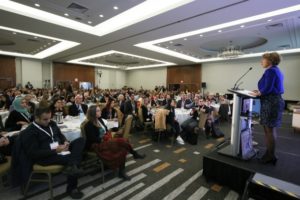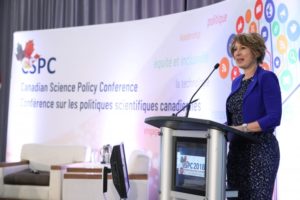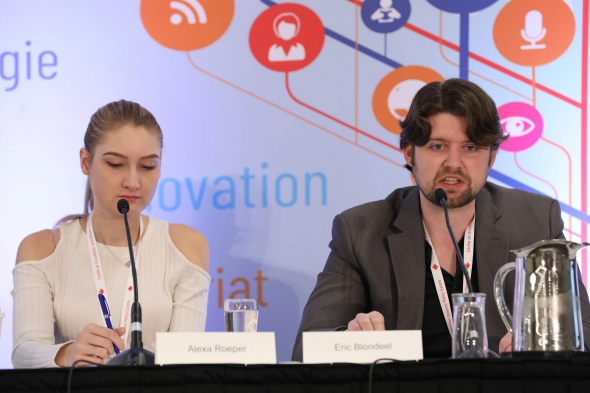Special

Day 3 – November 9th 2018
Takeaways and recommendations:
Waterloo’s Innovation Advantage – The University of Waterloo Innovation Ecosystem
Organized by: The University of Waterloo and the Institute for Quantum Computing
Speakers: Eric Blondeel, Chief Technology Officer and Co-founder, ExVivo Labs; Kristine Boone, Institute for Quantum Computing, University of Waterloo and Researcher, Quantum Benchmark; Adrien Côté, Science Lead and Business Advisor, UW Velocity; Alexa Roeper, CEO and Co-founder, Penta Medical
Moderator: Robert Lemieux, Dean of Science, University of Waterloo
What makes the University of Waterloo an innovation powerhouse?
Maclean’s magazine named the University of Waterloo Canada’s most innovative university in October 2018. While the news was welcomed, it didn’t come as any surprise at UW, which has won this coveted distinction every year since the magazine began its reputation survey 27 years ago.
Dr. Robert Leumeux, UW’s Dean of Science, credits this enduring success, in part, to having the largest student co-op system in the world, with over 20,000 placements at over 6,700 employers each year.
Another strength is its approach to entrepreneurship and commercialization. In 1957, UW became the first academic institution in Canada to adopt an inventor-owned intellectual property model which motivates researchers to turn their discoveries into products and services.
UW is credited with helping to transform the Waterloo Region into the third biggest tech cluster in Canada, behind Toronto and Montreal. Its homegrown successes include OpenText, Teledyne DALSA, Thalmic Labs and BlackBerry (formerly Research in Motion), as well as more than 1,100 start-up companies.
“That represents the second highest density of start-ups in the world, after Silicon Valley,” Lemieux told CSPC delegates.
Visionary UW graduates have been another driving force. The most notable has been BlackBerry co-founder Mike Lazaridis who in 2013 launched Quantum Valley Investments. QVI provides funding, expertise and support for researchers who develop breakthroughs in quantum information science that will lead to new commercializable technologies and applications.
Lazaridis’ philanthropy also founded two new research centres: the Perimeter Institute for Theoretical Physics in 2000 ($150 million donated) and the Institute for Quantum Computer (over $100 million donated).
“Mike’s vision of turning Waterloo into the quantum valley of the world is certainly moving forward. Waterloo is now on the map globally in quantum information technologies,” said Lemieux.
One of UW’s biggest strengths is nurturing student entrepreneurs through initiatives like Velocity, the largest free start-up incubator in the world. Since its launch a decade ago, Velocity has founded more than 300 companies that have secured over $800 million in capital. About 65% of Velocity start-ups are still operating after their first three years, and the majority of these companies were founded by undergraduate students.
Entrepreneurial students can receive support through the university’s commercialization office (Watco) and its Accelerator Centre, as well as the regional accelerator Communitech.
UW’s Velocity programs provide the knowledge, tools, space and network that start-ups and entrepreneurs need to succeed. Adrien Côté, Science Lead and Business Advisor at Velocity, said the program has two missions: supporting UW faculty and students, and scaling promising start-ups.
“We want to remove all possible points of friction for a student or faculty member … to explore and experience some element of entrepreneurship,” said Côté.
From idea to scale-up
One of the Velocity programs is Velocity Science. Embedded in the Faculty of Science, it offers a discovery and prototyping lab, mentoring and coaching to any student with a life materials science start-up.
Velocity Science was set up with acceleration in mind. Within just one or two years, students can go from idea to prototyping a product to incorporating a company and raising capital.
As companies start to scale, they move to the Velocity Garage, an off-campus incubator that provides a higher level of support to help young companies become independent and self-sustaining.
One graduate from Velocity Science and Velocity Garage is Alexa Roeper, CEO and Co-founder of Penta Medical, which is marketing a portable FDA-approved laser-therapy device that helps athletes recover from injuries. Key to her company’s success has been access to entrepreneurs who have launched a company, raised funding and secured regulatory clearance for a new product.
“Velocity Science does an excellent job in bringing those people in where usually they would be hard to access to because of the nature of how busy they are,” said Roeper.
Another student to benefit from Velocity Science has been Ph.D. candidate Kristine Boone. Her research led to the creation of Quantum Benchmark, which develops software tools to assess the performance of quantum computers. When the first Silicon Valley investors came on board, they wanted the company to move to California. But Boone said the company decided that staying in Waterloo was a competitive advantage because it’s a quantum centre with strong support for start-ups.
“Waterloo is a very different environment to grow a company in. Any help you would need to do anything, there is someone in town that can help you,” she said.
Eric Blondeel shared a similar experience with CSPC delegates. It was at Velocity Science where he met his future co-founder, fellow student Moufeed Kaddoura. Velocity mentors encouraged them to take their idea for a new allergy test to pitch competitions, and then form a company and travel to venture capital-rich California where they raised millions of dollars for their start-up.
Velocity encourages graduate students to believe they can be entrepreneurs – something many would normally never consider was possible, he said.
“It’s something I believe strongly in as a path, especially for Canada, because we have such a strong research ecosystem across the whole country. With a modicum of encouragement from programs like we have at Waterloo, the amount of creativity that could come out of our country is enormous,” said Blondeel, whose company, ExVivo Labs, is developing an easy-to-use allergy test that can accurately identify environmental and food allergy sensitivities.
But it’s much more than Velocity or even UW, adds Blondeel. The Waterloo Region has built an entire ecosystem that supports entrepreneurship. “We’re very lucky in Waterloo that there’s a pipeline to programs like Y Combinator, TechStars, Indie Bio, Hacks … these programs are networks of investors that allow Canadian companies to get off the ground.”
Looking ahead, UW plans to build a new Science Centre for Innovation. The 105,000 sq. ft. interdisciplinary facility will bring together world-class research groups, accelerator centres and entrepreneurs to work in areas such as ocular health, microbial biology, metagenomics and clean water.
The centre will also create a new home for Velocity Science as well as UW’s Science and Business program. As Lemieux explained, “You’ll have in one space an ecosystem for innovation, from basic fundamental science through to translational research to commercialization.”
But even more could be done, added Lemieux. The single biggest contribution the federal and provincial governments can make to grow this ecosystem is building a rapid transit line between Kitchener-Waterloo and Toronto.
“The (financial) capital resides in Toronto but there’s a physical barrier. On a good day it takes an hour and half to go from Toronto to Kitchener–Waterloo. This is where governments could make a tremendous impact on the growth of this ecosystem.”

Day 3 – November 9th 2018
Takeaways and recommendations:
Short Talk Series
Speakers: Milton Friesen, Program Director, Cardus Social Cities; Karen Bronsard, Policy Analyst, Centre of Expertise in Geomatics at Canada Centre for Mapping and Earth Observation, Natural Resources Canada; Ana Sofia Barrows, Social Media Manager, Lina Duque Consulting; Nicolette McGuire, Director, Research, Partnerships and Innovation Division, British Columbia Ministry of Health; Dr. Dana Devine, Chief Scientist, Canadian Blood Services; Lisa Varano, Audience Development Editor, The Conversation Canada; Tim Lougheed, Science Writers and Communicators of Canada; Alexandre Shiele, Researcher, UQAM East Asia Observatory
1. Conspiring Together for Good: Institutional Science and Religion — Milton Friesen, Cardus Social Cities
- The “social capital” of an urban environment can be inferred by tracking the way people, goods, and services move around a city. Mapping urban activities can reveal the internal workings of this complex landscape.
- This type of urban mapping can be trained on two significant types of institutions — those associated with science and religion — to identify areas of overlapping responsibility for the public good.
- A preliminary model of such urban imaging illustrates that while each institution retains its own distinct practices, they share important similarities in the social impact of those practices, such as an ongoing tension between their ability to help and harm the society they serve.
2. From Artificial Intelligence (AI) to Policy-Making: Changing How We Make Maps to Make Better Decisions — Karen Bronsard, Natural Resources Canada (NRCan)
- Following the 2017 season of highly damaging river floods in eastern Ontario and Quebec, NRCan reviewed ways in which its geospatial data platforms might have been able to assist the response to this crisis.
- By applying AI algorithms to NRCan’s existing databases, analysts were able to produce 3-D maps that illustrated the extent of the flooding and would have been able to predict its impact in real time.
- This information could have been used by first responders to determine how particular sites were being affected and what could be expected to happen there.
- Other applications of this technology include using existing geospatial data to assess how well-situated particular houses are for solar panel installations — a potential real estate selling point — as well as the impact that invasive species are having on urban forests.
3. Amplify: Managing Microaggressions and Countering Stereotypes Against Women and Girls in STEM — Ana Sofia Barrows, Ryerson University and Ontario Science Centre
- Microaggressions are subtle social exchanges that challenge an individual’s identity within a particular group.
- This behaviour may be felt by girls with an interest in science and technology (S&T), traditionally viewed as male activities. The effect, either consciously or unconsciously, may be sufficient to discourage these girls from pursuing their interest in these fields.
- The impact of microaggressions can be countered with similarly “micro” responses, minor affirmations that confirm and reinforce group membership whenever it is questioned.
- Successful implementation of such a strategy relies on both sides learning more about human diversity, as well as how to accept feedback from one’s peers.
4. Putting our Minds Together: Research and Knowledge Management Strategy — Dr. Nicolette McGuire, BC Ministry of Health
- Elected officials are the most prominent drivers of policymaking within government. But in reality, people from outside government contribute significantly to policy formation through entirely different channels.
- A British Columbia Ministry of Health report identified the resources government staff can access to better engage researchers and others who could provide input into policymaking.
- The report outlines the kind of formal and informal expertise that can be brought to bear on the ministry’s activities, from hard scientific data about new drugs to the lived experience of individuals within the health care system.
- An innovation “hub” that serves as a central point of contact for people and information is an effective way to bring evidence to bear on the development of government practices.
5. From Crisis to Confidence: Building Science and Policy “Bridges” in Canada’s National Blood System — Dr. Dana Devine, Canadian Blood Services
- The tainted blood crisis of the 1980s and 1990s, which saw about 2,000 Canadians infected with HIV from contaminated blood products, represents a profound failure of the country’s public health system.
- After an extensive inquiry into the causes and dynamics responsible for this crisis, the federal government created an entirely new organization — Canadian Blood Services — to prevent such problems from recurring.
- At the heart of this agency was the commitment to a strong relationship between the country’s research community and officials responsible for health policy, forming bridges with the expertise necessary for ensuring that blood handling procedures are based on the best available evidence.
- Canadian Blood Services has helped to build this expertise, including the development of research infrastructure across the country and training individuals to operate at the forefront of fields like transfusion medicine.
6. How a New Model of Journalism is Connecting Science and the Public — Lisa Varano, The Conversation Canada
- Technology has radically altered the nature of the media industry over the last 25 years by introducing innovative approaches to delivering current events and other information to mass audiences.
- One of the most successful of these new models for S&T has been The Conversation, an online service that provides professionally edited material written by researchers, scholars, and other members of academia.
- Its official slogan — “academic rigour, journalistic flair” — is intended to capture the two key elements that distinguish The Conversation’s content: perspectives from authoritative expertise in technical fields, and an accessible, engaging prose style.
- Supported by 26 universities and other funding partners, The Conversation is a non-profit enterprise, freely available and without the advertising associated with most online news operations. Other media outlets regularly republish content from The Conversation, which is free of charge.
- Early in its operation The Conversation received over one million page-views every month, while some individual articles have drawn hundreds of thousands of page-views on their own.
7. Mapping the Science Writing and Communication Landscape in Canada Using New Media and Traditional Survey Research Tools — Tim Lougheed, Science Writers and Communicators of Canada and Alexandre Schiele, UQAM Interuniversity Research Center on Science and Technology
- Contemporary audiences are enjoying unprecedented access to well-written and researched science journalism, but there is a paradox at the heart of this “golden age” — media enterprises have been financially devastated in recent years. This has dramatically reduced the ranks of the people who can produce this kind of material.
- Two professional bodies within Canada whose members are dedicated to science communications — the Science Writers and Communicators of Canada and the Association des communicateurs scientifiques du Québec — collaborated on a formal survey to determine who is currently engaged in this kind of work, including how and why they do so.
- The results confirm that only a fraction of the people engaged in science writing fall into the category of traditional media careers. At least half operate in some capacity as freelancers, while another significant cohort work as communications staff for institutions, mostly universities, where not all communications covers science.
- The channels employed for science communication have also changed significantly, with a large proportion of information being transmitted through high-profile social media such as Facebook, Twitter, and YouTube.
- Among those who make their living in science communication, the ability to generate income was listed as a leading challenge, along with the ability to support the travel or research necessary to carry out this work.

Day 3 – November 9th 2018
Takeaways and recommendations:
Brainstorming for Canada’s National Water Vision
Organized by: Pacific Water Research Centre and Ryerson Urban Water
Panel 1
Speakers: Nick Reid, Executive Director, Ryerson Urban Water; Courtney Bridge, Graduate Student, Simon Fraser University; Larry Swatuk, Director, Master of Development Practice (MDP), and Associate Professor, School of Environment, Enterprise and Development at the University of Waterloo; Merrell-Ann Phare, Executive Director, Centre for Indigenous Environmental Resources; Irving Leblanc, Director, Housing, Infrastructure & Emergency Services, Assembly of First Nations; Elizabeth Hendriks, Vice President, Fresh Water Program, WWF Canada; Jeff Hall, Professor in the School of Civil Engineering, Queens University
Moderator: Banu Örmeci, Professor and Jarislowsky Chair in Water and Global Health, and Canada Research Professor, Carleton University
Takeaways and recommendations
Background and motivation
- Canada has a rapidly-worsening water crisis. The only response is a national response.
- Canada does not necessarily have water where it is needed.
- Water is like climate change in that we’re not all impacted equally.
- There is momentum to create a National Water Vision for Canada. These talks are part of the continuum of conversations on developing that vision.
- Federally, Canada currently has the Canada Water Act of 1970 and the Federal Water Policy of 1987.
- Canada does not have federally-enforced drinking water standards.
- 20 federal departments are responsible for freshwater.
- There is a lack of water monitoring: no federal agency is dedicated to water, no standards exist for monitoring, and there is no national database for freshwater data.
- Canada has not declared access to water a human right.
- 14 of the 17 United Nations Sustainable Development Goals can be directly connected to water.
- Canada’s most important natural resource, according to Canadians, is fresh water. (RBC Canadian Water Attitudes Study)
- 2018 marks the beginning of the International Water Decade Alliance: Water for Sustainable Development (2018-2028). The Alliance is open to new members.
A Canadian water vision
- The national vision must take into consideration:
- The intersection of water and human rights
- How to share water across borders
- The drivers of water insecurity (climate change, population growth, etc.)
- Focus on drinking water. It is a low-hanging fruit.
- Particularly with citizen science and monitoring, expertise is needed to help guide what the data mean and where the monitoring should go in the future.
- The vision needs to be followed by a strategy that includes data: track processes, make stakeholders accountable, and share resources.
- Canada needs a culture of courage: fail quickly and fail fast.
Canadian legislation and the Canada Water Act
- We try to protect the things we care about most by creating a law, and putting money where the law is. We legislate when we care.
- We need a law that will give the water issue teeth.
- A foundation exists already – the Canada Water Act. However, it is deficient and needs updating.
- We have no capacity for national drought and flooding forecasting, etc.
- The Canada Water Act should be more than an enabling act. It needs to require mandatory actions and enforcement in certain circumstances from governments across the country:
- Designate significant waters for protection and restoration.
- Set and enforce minimum standards to address or prevent cumulative effects on river basin health.
- Mandate integrated river basin planning and management
- An updated Canada Water Act should be developed in partnership with Indigenous Nations so as to ensure that UN Declaration on the Rights of Indigenous Peoples, Truth and Reconciliation Commission Calls to Action, and nation-to-nation relations are respected.
Indigenous peoples and water in Canada
- Drinking water advisories are a major problem in indigenous communities.
- Look at water infrastructure in indigenous communities.
- Governance solution: Indigenous governments have their own water laws, and they are creating their own rights.
- Indigenous government water policies need to be integrated into other Canadian policies.
- A Canadian water vision should use a “made in Canada” approach. Indigenous cultures should be full partners.
- Bring the First Nations holistic views on water to discussions about a water vision.
- From a First Nations perspective, technology is allowing for quick and on-place water quality data.
- Many indigenous communities are lacking water security, and have insufficient waste water treatment.
- Treaties with colonials did not include giving up water.
- Indigenous perspective: Water is the creator’s gift, and a living being that needs to be respected and protected.
- The Truth and Reconciliation Report’s Calls to Action include a UN Declaration on the Rights of Indigenous Peoples, with water rights embedded.
- For First Nations, the very starting point is to respect their rights. Top-down solutions do not work. Often at these talks, it is “privilege talking to privilege.” There is a disconnect from impacted people.
Canada’s water resources
- In 2017, World Wildlife Fund (WWF) Canada released the Canada Watershed Reports.
- Not understanding our water resources is a major challenge for Canada.
- Of Canada’s 167 sub-water sheds, 110 lack data for watershed health.
- WWF’s Living Planet Report found an 83% decline in fresh water species globally in the last 40 years.
- Over 10 million Canadians get their water from groundwater, yet Canadian groundwater has not been fully mapped.
Canadian groundwater
- In many cases new developments regulate wells a certain distance from a septic system, but that is not the case for older communities, where septics and wells may be interacting.
- There is a wide variety of types of wells.
- Testing standards for groundwater vary by province. Water quality can vary day-to-day.
- Wells can run dry in severe drought conditions, yet forecasting is lacking.
- Canada should have a national approach to monitoring groundwater and wells.
- People need to understand where their water comes from.
Panel 2
Speakers: Nancy Goucher, Knowledge Mobilization Specialist, Global Water Futures, Water Institute, University of Waterloo; Francis Scarpaleggia, Member of the Canadian Parliament for Lac-Saint-Louis; Julia Baird, Assistant Professor, Environmental Sustainability Research Centre at Brock University; Ogimaa Kwe (Chief) Linda Debassige, M’Chigeeng First Nation; Lisa A Prime, Principal Consultant, PRIME Strategy & Planning, Ryerson Urban Water Advisory Board Member
Moderator: Zafar Adeel, Professor, Resource and Environmental Management at Simon Fraser University; Executive Director, Pacific Water Research Centre
Takeaways and recommendations
A Canadian water vision
- A paradigm shift is necessary – water views within Canadian culture need to change.
- Canada needs to be more proactive in our decisions around water, particularly related to chemical use.
- Water is a complex issue: there are many jurisdictions and stakeholders.
- The watershed is indeed central to protecting Canada’s freshwater resources. However, watersheds are not a sexy political handle for engaging Canadians at the ballot box on the issue of water.
- We need a compelling narrative on water to win the interest of Canadians, which is a prerequisite to making change happen.
- We need to understand what data are required, based on what will be done with the data.
- Policies need flexibility, and to include the use of metrics.
- Continue the dialogue – get the right people to the table, initiated by government.
- If climate change is a shark, then its teeth are climate change’s impacts on water. Climate change is about water.
- A Canadian water vision needs:
- To win the hearts and minds of Canadians. Water is a human problem first. Use storytelling.
- Collaboration: We need to have First Nations at the table and water people need to talk to people outside the water community.
- Targets and timelines: Make use of current momentum, review results of implemented change, improve water protection, share stories of success and monitor water using quantitative measurements.
- Global positioning: A vision for Canada must take into account that we are part of a global community. We are responsible for protecting 20% of the world’s fresh water.
Canada on the international stage
- Water, and water security in particular, can be a new source of international leadership for Canada.
- If we focus on the United Nations’ Sustainable Development Goal 6, we can share our expertise in many water areas.
- We are a water nation; water is part of our Canadian identity, yet we are not present on the international stage.
- If we take an international leadership role, then we can get all Canadian water stakeholders, including industry, to work on the problem (of global water security), which would also support domestic action to consolidate Canada’s own water security.
Water as a social-ecological challenge
- We should look at water from a resilience perspective: how we might formulate a vision, including how we engage Canadians in the process?
- It is about social-ecological systems: complex interactions between our society and our environment.
- This perspective entails persisting, adapting, and transforming (shifting and finding new ways).
- The key principles that underlie the social-ecological perspective are to:
- Broaden participation (not just about politicians having this discussion)
- Learn and adapt
- Acknowledge that it is a complex system
- Collaborate across scales (including data sharing across groups and institutions)
- Draw on the vast amount of research that has been done on climate change skepticism and engaging the public, and changing attitudes and behaviours. What we have learned from this research can help us to engage the broader public more effectively.
Indigenous perspectives
- A generation ago people could drink water from Lake Huron. Now the water must be treated. Young people only know of treated water – they have never been able to drink from the lake.
- We need to invest funds that will support keeping water healthy.
- A caution: if we talk about protecting water or the technical-economic ideas surrounding water challenges, we sometimes miss the cultural-spiritual part. Keep the two parts in mind.

Day 3 – November 9th 2018
Takeaways and recommendations:
Equity, Diversity and Inclusion (EDI) in Science: from Policy to Implementation
Organized by: Imogen Coe, Faculty of Science, Ryerson University
Speakers: Dr. Art Blake, Associate Professor and ECI Faculty Chair, Ryerson University; Deanna Burgart, Self-proclaimed Indigeneer™; engineer, speaker, and mentor; Dr. Danika Goosney, Associate Vice-President, Tri-Agency Institutional Programs Secretariat; Dr. Steven Murphy, President and Vice-Chancellor, University of Ontario Institute of Technology
Moderator: Imogen Coe, Professor, Chemistry and Biology, Ryerson University
Takeaways and recommendations
EDI is excellence
- Policies for EDI are policies for excellence.
- Groups that are more diverse perform better.
- Participants who feel fully included will also perform better.
- It is important to frame issues involving EDI as issues of innovation, discovery and excellence.
EDI is intersectional and multi-faceted
- Often, groups of people (women, Indigenous people, etc.) are treated as a single homogenous group.
- There are varying privileges in terms of age, language, gender identity, backgrounds, cultures, skin colour, socioeconomic status, disabilities, sexual orientation, etc.
- Trans people, for example, are often left out of the gender conversation, and yet they face extreme systematic barriers.
- This intersectionality needs to be part of every EDI conversation.
Honest conversations are critical
- In many cases, those charged with enforcing EDI focus on achieving short-term goals and mandates, rather than why EDI is important.
- Strengthening EDI in science is an economic imperative. This fact is becoming increasingly recognized by policymakers, funding organizations, post-secondary institutions and other parts of the research ecosystem.
- Effective social change takes time and is difficult for several reasons: i.e., perceived challenges to power can incite pushback; policy development can be slow and complex.
- Though many have trouble admitting it, there is systemic racism and sexism in Canada.
- EDI discussions make people feel uncomfortable and therefore they may avoid the conversation. This situation is exasperated in Canada where people are conditioned to be polite and non-confrontational.
- Theses tendencies can result in bias and prejudice staying hidden and unchecked.
- Explain that discomfort is a normal and healthy part of the process of achieving EDI.
EDI is a core competency
- Many EDI initiatives target K-12 youth, but without broader systematic change these efforts are often dropped by high school.
- Although mentors can be hugely effective, the data show the effect is only short-term.
- Canada needs to create a culture where everyone gets training on how to be a good ally, how to call out bad behaviour, implement an EDI culture, etc.
- We need to teach EDI principals and skills as a core part of our education system, from kindergarten to post-secondary. This will help society move from a culture of compliance (i.e., where people just do something because they think they should/ might be penalized) to one where understanding and implementation of EDI principles becomes an expected competency.
Changing the organizational climate
- The most predictable predicator of harassment is the organizational climate.
- Organizations must make system-wide changes to make a difference (not just one-off events like a STEM camp for girls).
- Initiatives must be supported by, and sometimes originate from, the people in power.
- It is not always easy to enact change, even for people in positions of power. Strategies to succeed include coming to the table with specific issues you want to champion, and as you enact them, knowing which battles are the right ones to spend energy on.
- Usually, just telling people they are wrong, racist, etc. will not work. Rather, come up with creative strategies that help others understand that everyone will do better if the workplace is more diverse and equitable.
- If an organization/institution is adjusting an operation (e.g., peer review), it should not assume it has the expertise to do this itself – EDI professionals need to be engaged.
- There needs to be real consequences (i.e., incentives for compliance and/or punishment for non-compliance) for EDI targets.
- Mandatory EDI training is critical but it has to be done in a productive way.
Creating a productive learning environment
- It is difficult to involve people in EDI training if they see it as a waste of their time.
- Lectures are ineffective in EDI training. People have to feel they are part of the conversation and understand that it affects everyone.
- Blaming and shaming do have their time and place, but in an educational environment they tend to be counterproductive.
- Making training ‘fun’ (e.g., quizzes, gamification) can help break down people’s prejudices/fears and engage them so they will actually listen.
- The learning environment needs to be a place people can say the wrong thing or make mistakes so they feel comfortable getting involved in the activities or discussion.
- There may need to be consequences for people who don’t go or who fail training –otherwise, some people won’t put in an effort.
Making EDI a priority
- Government and institutions often have no specific deadline for achieving EDI, which can make EDI seems like a lower priority.
- Ideas for those working on internal EDI initiatives include:
- If there are other departments/organizations/etc. that are ahead of you in implementing EDI policies, actively and vocally compare yourself to them.
- Articulate why EDI is important to excellence.
- Be persistent – keep talking to everyone about the EDI work you are doing and why.
- Find influencers and people who are in power who care, and others with a strong passion for the work, and engage them.
- Don’t just focus on the negative. Celebrate, as frequently as monthly, and then educate to raise awareness (e.g., Ada Lovelace Day, Trans Awareness Month). Such celebrations are often low-resource and difficult to criticize.
- Keep all EDI work intersectional; e.g., if you are working on the gender file, celebrate Black History Month and Pride Week, and include trans folk in the conversation.
- Those who are invited to speak (and have the power/privilege to do so) should hold conferences accountable by refusing to attend if they don’t have an acceptable code of conduct.
Metrics are important
- Effective policy is transparent, evidence-informed and data-driven.
- The government and institutions need to collect and analyze EDI data to know if progress is being made and if efforts need to be adjusted.
- Assign resources to ensure measurement is done properly.
- Avoid reporting on just women or visible minorities generally. A deeper dive is needed to drive meaningful change.
- Data can speak for people who don’t have a voice or may get into trouble for speaking up.
Indigenizing and decolonizing systems
- Indigenizing is a large systemic overhaul that includes adding examples, perspectives, worldviews, etc. so that Indigenous people see their non-homogenous selves respected.
- Most systems currently ask Indigenous, Inuit and First Nations to come into a western structure and assimilate. More work is needed on listening to their knowledge and learning about their structures.
- Institutions need spaces where non-Indigenous people are exposed to, and can begin to understand and accept, Indigenous perspectives.
- Canada need not start from scratch There are many places it can look for models and best practices:
- New Zealand is well aligned and integrated with Maori in research.
- SACNAS (Society for Advancement of Chicanos/Hispanics and Native Americans in Science) has a conference that is completely STEM focused but designed and implemented in a culturally appropriate way.
- AISES (American Indian Science and Engineering Society) focuses on “substantially increasing the representation of American Indians, Alaska Natives, Native Hawaiians, Pacific Islanders, First Nations and other indigenous peoples of North America in science, technology, engineering and math (STEM) studies and careers.”
Canada needs more nation-wide organizations championing the cause
- There are good examples of nation-wide organizations pushing EDI forward in other countries (e.g., WISE campaign and Athena SWAN in UK, and Male Champions of Change in the US).
- Canada does not have any initiatives like these, though recent commitment to adopt Athena SWAN is a positive step.
Insights on being an ally
- Everybody can be champions, allies or sponsors.
- “Allyship” is an action, not a philosophy.
- Educate yourself: what you can say depends on where you are and what the context is.
- There are lots of helpful resources including books and trainings on allyship
- Become an ally for systemic change in your institution (e.g., ask for EDI training).


Day 3 – November 9th 2018
Takeaways and recommendations:
Policy and Funding Models for Graduate Students and Postdoctoral Fellows
Organized by: University of Toronto, Helen Lasthiokis
Speakers: Alejandro Adem, CEO and Scientific Director, Mitacs Inc.; Dr. Martha Crago
Vice-Principal, Research and Innovation, McGill University; Bonnie Le, Ph.D., Banting Postdoctoral Fellow, Rotman School of Management, University of Toronto; P. Kay Lund, PhD., Director of the Division of Biomedical Research Workforce, NIH Extramural Research Training Officer in the Office of Extramural Research, Office of the Director, National Institutes of Health
Moderator: Vivek Goel, Vice President, Research and Innovation, University of Toronto and Professor in the Institute of Health Policy, Management and Evaluation, Dalla Lana School of Public Health
Takeaways and recommendations:
National Institutes of Health (NIH) Policy and Funding Models
- 3% of the operating budget of the U.S. National Institutes of Health (NIH) goes to training; 2% goes to career development.
- The NIH covers a range of programs: from graduate and clinical training to post-doctoral clinical residency to early career.
- NIH has increased stipends for graduate students and for post docs every year and has secured funding to do this over the next few years.
- Full-time research is a prerequisite for training awards and fellowships, but up to 25% of students’ time can be spent doing things that they can get paid for, which helps to alleviate the cost of living and enhance career development.
NIH National Research Service (NRSA) Awards
- These program awards ensure highly trained scientists are available to address the nation’s needs.
- There are two types of NRSA Awards:
- Institutional training programs (T series): Award institution training for grad students and/or postdocs, including clinicians. It must have a program director and experienced faculty.
- F-32 is for postdoc fellows.
- Currently available only to US citizens.
- NRSA Awards have led to three times the number of postdocs than grad students being funded on a single research project grant.
- It can be difficult to determine impact on the career of recipients because they are often listed on more than one grant.
- Over the past 20 years, pre-doctoral fellowships have increased more than 300%; in comparison, postdoc fellowships have decreased 36.4%.
- Postdoc fellowships have a significant positive impact on subsequent independent NIH support, but have decreased by almost one-third. It is not clear why the NIH has decreased the number of fellowships.
- The major exit point from the biomedical research workforce in the US is the postdoctoral to faculty transition, especially among women and other under-represented groups.
NRSA Award Recommendations
- Continue to increase stipends and benefits.
- Create more opportunities to transition to independence.
- Extend the current three-year postdoctoral limit for clinicians to four years.
- Enhance and promote intern and experiential learning opportunities (“externships”) to facilitate career development in other labs, institutions and agencies in areas of communications, policy and industry.
- Promote the ability of pre- and postdocs to receive entrepreneurial training so they have the skills to work in either academia or industry.
- Data science, computational science, rigor and reproducibility need to be incorporated into all NIH training and fellowship programs.
NIH Career Development (K) Awards
- K awards promote successful independent careers (i.e., tenure-track) through mentored training.
- Many of these awards have a significant impact on receipt of independent NIH R01 awards
- There is a greater impact for women and under-represented groups with K awards.
- The R00 award promotes earlier independence; but cannot evaluate it because it’s not reviewed.
- K awards delay the time to trainee’s first R01 for some K awardees.
- Some extramural institutions only accept applications from candidates with an R00.
- Varied levels of salary with these awards; need to make merit-based.
- It is difficult for a physician to commit 75% of their time to research; 50% is a more realistic target.
- Trainees should have more than one mentor – ideally outside the department.
The Canadian landscape
- There are three key frameworks for funding models in Canada:
- Direct awards to trainees
- Training grants or programs awarded to institutions to award to trainees
- Support for trainees received through their supervisor’s research grants
- Postdoctoral enrollment in Canada has increased 50% in 15 years, with most of that growth happening over the past decade (Statistics Canada).
- Approval on the number of grad students to support is given separately from funding approval, resulting in disparity. Furthermore, these decisions are assigned to different levels of government, creating the pressure we see now.
- Budget 2018 has not acted on any of the Fundamental Science Review’s recommendations related to scholarship/fellowship programs or funding. Instead, government resolves to do more work to determine how best to support the next generation through scholarships and fellowships.
- To date there’s been no consultation around this topic by the Canada Research Coordinating Committee.
- Many academic organizations agree and are aligned with the Fundamental Science Review’s recommendations and have submitted their views as part of the current pre-budget consultations.
- High residency and medical school debt can lead some graduates to decide against careers in research.
- Canadian funding models for international grad students:
- International grad students are only eligible for a subset of funding possibilities.
- The opportunity to apply is valuable; it encourages self-direction at the early stage of the academic career.
- Grant writing helps trainees think about how their research can have impact at a societal level.
- Receiving funding allows for more self-directed research.
- Banting Fellowships are available to international students.
Recommendations for Canada
- The tri-council agencies should consider implementing a suite of postdoc and grad student support programs across the career span. This could include career development awards, like NIH K awards, that support mentored research toward independent research careers.
- Create more joint programs between under-resourced institutions and research-intensive institutions so experience is gained by a diverse group of applicants.
- Consolidate funding under one umbrella.
- Look to Quebec – it has postdoc/grad student support programs that could be replicated federally.
- The K awards are beneficial for career advancement, retention in research and diversity. There is a need to explore similarities and differences between NIH and Canadian models.
- Consider programs designed to promote retention in residency (see New Institutional ‘Research in Residency’ R38 Program NOT-HL-18-639, followed by individual K38 award designed to promote retention in research NOT-HL-17-533).
- Explore the feasibility of partnering more research intensive labs with less resourced/minority serving institutions. NIH’s Institutional Research & Career Development Awards (IRACDA) do this. A similar model in Canada is the joint St. Francis Xavier University/Dalhousie University Chemistry program.
- Programs need to be evaluated on both metrics and impact.
- Emphasize the value and importance of research, rather than focusing on how difficult it is.
- Flexible funding makes it easier to design programs that support entrepreneurship.
- For internships/entrepreneurial postdocs, build soft skills and project management training into the program. Offer these independently at campuses across Canada. This helps students learn industry culture and standards of behavior.
- Data science should be part of Canada’s discussions on the need for soft skills.
- Important to incorporate different types of trainings for different types of disciplines.
- Look at how both funding and mentor support can do a better job at accelerating the time needed to complete a PhD.
- Recognize that mentors and sponsors are different. Mentors are important but need someone ready to advocate for you—a sponsor—who is different from a mentor.
- Enhance experiential learning opportunities, e.g.:
- Provide students with experiential learning opportunities such as internships; bringing research to their place of work complements their theses.
- NIH’s Broadening Experiences in Scientific Training (BEST program) gives grad students and postdocs experiences outside the lab.
- Increase the value of grants to increase to sustain and support postdoc research.
- MITACS make up a significant portion of internships for postdocs and grad students in Canada.
- We need more research taking place in industry.
- We need interdisciplinary research.
- Identify and adapt fellowship best practices, such as:
- Granting agencies should require transparency from supervisors about what they can/are prepared to offer to the student.
- Student fellows should interview potential supervisors to determine the benefits of working with that particular supervisor. This will help prevent a dysfunctional research situation.
- As a researcher, it’s important to have a “science family.” Portable fellowships earned entirely by the student carry the risk of students going into less than ideal research situations, i.e., an isolated situation away from a lab with other researchers.
- Fellowship applications, both at the NIH and in Canada, should include a statement from the mentor on how they will support the student/postdoc to the next stage.

Day 3 – November 9th 2018
Takeaways and recommendations:
Symposium: Supporting Canada’s Energy Transition – Bridging the Gap between Fundamental Research, Industry, and Policy
Organized by: Queen’s University
Speakers: Carolyn DeLoyde, Ph.D Candidate, Geography and Planning, Queen’s University; Michael Fraser, Vice-Principal (University Relations), Queen’s University; Monica Gattinger, Director, Institute for Science, Society and Policy; Praveen Jain, Professor, Canada Research Chair, Electrical and Computer Engineering, Queen’s University; Warren Mabee, Head and Professor, Department of Geography and Planning Queen’s University; Trevor Nightingale, Principal Research Officer for the Construction Research Centre, National Research Council; Ron Oberth, President, Organization of Canadian Nuclear Industries; Laura Oleson, Director General of Energy Policy, Natural Resources Canada; Joy Romero, Vice President Technology & Innovation, Canadian Natural Resources Limited; Kimberly Woodhouse, Vice-Principal (Research), Queen’s University
Takeaways and recommendations
- Energy now occupies the nexus of economic and environmental priorities, a position very different from a generation ago when energy issues were not regarded as being directly linked with either the economy or the environment.
- In 2017, Natural Resources Canada undertook Generation Energy, a national dialogue intended to glean the views of people from across the country on the best way of dealing with climate change, economic sustainability, and the affordability of energy.
- Some 380,000 people contributed to Generation Energy, which identified four of the most desirable pathways forward: reducing energy waste; switching to clean energy; using more renewable energy; producing cleaner oil and gas.
- There is no shortage of policy strategies for making sound energy decisions — the real gap lies in building public confidence to support these initiatives.
Changing perceptions of energy
- The structure and mandate of longstanding institutions that were set up to frame policy, such as the National Energy Board, have been overshadowed by sweeping social and technological changes that have given Canadians a very different set of priorities, such as climate change or Indigenous reconciliation.
- People responsible for policy and regulation, whose own mandates are governed by these same institutions, find themselves targeted by highly public critiques of how Canada is approaching the energy sector.
- The language used to discuss energy topics has evolved considerably, along with more potential for confusion. Advocates for low-carbon fuels may refer to low-emission fuels instead, which call for entirely separate strategies and possibly different types of fuels. Similarly, advocates employ “clean” to refer to a variety of different products or methods, which might respectively be less polluting, create fewer carbon emissions, or use more benign feedstocks, but no one on its own will achieve all of these goals.
- The energy industry has worked hard to make great strides, such as bringing the cost of oil produced from oil sands below that produced by fracking, while still observing ever more restrictive limits on carbon emissions.
- Such progress frequently goes unreported, even within industrial circles; Norway was going to divest its holdings in Canadian Natural Resources Limited in objection to the company’s use of oil sands, but after a detailed explanation of the firm’s environmental impact, the Norwegians increased their investment.
Building confidence
- The concept of energy varies across the provinces, from oil and gas in the west to hydroelectricity in the east. A common national vision of energy must become an integral part of any accepted policy.
- A Generation Energy poll found that fully half of Canadians thought the country had a poor vision for the energy sector and for improving how Canadians obtain and use energy.
- Claims of progress from the energy industry have little credibility for many Canadians, who want to see such information verified by credible third parties.
- Canada’s oil and gas sector has been a leading source of new clean technologies, but Canadians are renowned for their lack of pride in domestically developed industries. Government policy should be aimed at highlighting these gains as part of its high-profile effort to create a “national brand”.
- Such a brand must be based firmly on scientific foundations, ensuring credibility that goes far beyond a typical advertising pitch. It must be accompanied by efforts to increase public literacy of these technical matters, so that the science is understood and accepted by Canadians.
- An energy policy that builds confidence will lead the transition to new energy platforms, provide Canadians with the ability to embrace those platforms, and secure the resulting changes in the form of standards or regulations.

Day 1 – November 7th 2018
Takeaways and recommendations:
New directions for science advice in federal government
Speakers: Sarah Gallagher, Science Advisor, Canadian Space Agency (CSA); Donna Kirkwood, Chief Scientist, Natural Resources Canada (NRCan); Dan Wayner, Science Advisor and Chief Science Officer, National Research Council (NRC)
Moderator: Toby Fyfe, President, Institute on Governance
How to link policymakers and scientists for better decision making
Prime Minister Justin Trudeau caught the attention of Canada’s scientific community when he took office in 2015 pledging that political decisions would be based – or at a minimum informed – by robust scientific evidence.
“This is a golden opportunity to demonstrate the value of science,” said NRCan Chief Scientist Donna Kirkwood.
But how does that process work in the real world where policymaking and science have different cultures, timelines, priorities and ways of communicating? Do the politicians value science and integrate it into their decision making? Within the public service, are we witnessing a shift in mindset and practice that engages science at the beginning of policy and program discussions?
And in a world where big data keep growing while public trust in “facts” wanes, is the government science community ready, willing and able to drive government agendas such as policy making and regulatory reform?
Those were among the questions the Institute on Governance’s Toby Fyfe asked the panel of science advisors.
“For the government to value science, I don’t see that there’s a challenge there. Where I see a greater challenge is integrating science into decision making,” said Kirkwood.
She identified three main roles for science in government: to support the public good (e.g., understanding the state of Canada’s forests); to fulfil federal responsibilities (e.g., regulations, standards, laws, policies); and to inform politicians on specific issues.
Relationship building is key
According to Kirkwood, mismatched timelines are the biggest hurdle to integrating science into policymaking. Policymakers need to make decisions within weeks, days or even hours. Scientific research can spans years if not decades.
“It’s up to both communities to understand that it’s important to feed the right information at the right time,” she said. Strong relationships and trust between policymakers and scientists are key, which means scientists need to be part of any discussions on an issue from the beginning.
The CSA’s recently appointed Science Advisor said the best way to build relationships and trust is to embed scientists on policy teams where they can better understand what bureaucrats and politicians need.
“As an advisor, you spend most of your time listening, to the people with the scientific knowledge who can contribute to the conversation, and to those who need advice,” says Dr. Sarah Gallagher, who reports directly to the CSA’s President.
Gallagher is one of several departmental chief science advisors (DSAs) — outside experts, often from academia – who are being appointed to provide scientific support to policymakers. The UK and New Zealand are among the countries with DSA networks.
Gallagner describes these external advisors as “internships for grown-ups”.
“You have somebody with the capacity who can integrate that scientific data, share it in a digestible form with their colleagues so that data can be incorporated where it’s needed … at every step of the decision making policy process,” says Gallagher, who continues to hold an associate professorship in astronomy and astrophysics at Western University.
Use language bureaucrats can understand
For science advice to be effective, it needs to be communicated in a way that is useful and understandable to policymakers, said Dan Wayner, who in September became the NRC’s first Science Advisor and Chief Science Officer, reporting directly to the NRC’s President.
“Scientists are really good at communicating with each other but not so good at communicating with people who aren’t scientists and most decision makers are not scientists,” said Wayner. “We need to be able to condense the meaning of the scientific outcome, result or body of evidence into something they can understand for decisions.”
Another challenge for decision makers, said Wayner, is that new technologies are arriving on the market faster than science can discern their economic and societal impacts and implications. It’s also becoming more difficult to rapidly analyze the tsunami of data being generated from a seemingly unlimited number of sources.
Sharing knowledge across government is a perennial issue, particularly data that are relevant to multiple departments.
“We need to understand not only how to integrate evidence into departmental decisions but how we integrate across departments and across government,” said Wayner, adding that new technologies such as artificial intelligence can also be utilized to develop policy.
Progress is being made among departments to work more collaboratively both internally and externally, a change Kirkwood said “is being driven by the highest levels all the way down”. For example, the Deputy Ministers Science Committee meets regularly to discuss issues like how artificial intelligence and quantum computing can help to improve the decision-making process.
Just the facts
What happens when the government of the day isn’t a strong advocate for evidence-based decision making, and what if you as a scientist disagree with a particular policy or decision, Fyfe asked the panel.
Scientists need to be “honest brokers” that provide advice based on rigorous, credible and relevant evidence, not opinions, cautioned Kirkwood.
Wayner agreed, saying “My job is not to judge the policy, but to provide information that supports an evidence-based decision…. There’s a difference between giving advice and trying to influence. This is arms-length advice.”
At the same time, science advisors need to acknowledge that they may not have all the answers. “We need to recognize the limitations of the evidence we present… It’s complicated. We give an opinion on the best available information,” said Wayner, stressing that scientific evidence is just one input into decision making.
Strong linkages between government science, industry and academia are also important. “A healthy scientific community has all three pillars,” Gallagher told delegates. “By working together, it makes them more robust to what could be happening on the top political level.”
At the CSA, for example, various directors have external advisory communities, drawn largely from academia, as well as other government departments.
However, Wayner noted that government and academia have difference governance structures that can make collaborations difficult. Siloed behaviour, he added, has also become entrenched for some in government, “and behaviours are difficult to change quickly”.
Galagher said that culture change will inevitably be driven in large part by young entrants to the public service who thrive on collaboration and networking and understand its importance. “It’s not just about bringing the right experts with the right disciplines but also ensuring in the public service that we have people who realize benefits of bringing people together … what skills and competencies do we need to enable these relationships to happen?”
Lastly, Kirkwood said open science and science literacy are critical to bridging the gap between science and policy, while also building public trust by making both the scientific research and decision making process more transparent.

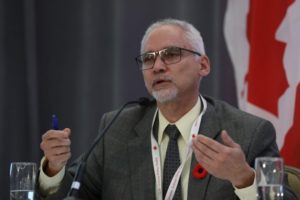
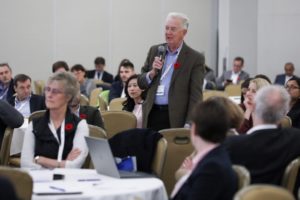

Day 1 – November 7th 2018
Takeaways and recommendations:
AGE-WELL 2020: Charting the Future of Technology and Aging Research in Canada
Speaker: Mimi Lowi-Young, MHA, Chair, Board of Directors, AGE-WELL NCE Inc.
AGE-WELL launches Canada’s technology and aging research agenda at CSPC
The AGE-WELL Network of Centre of Excellence (NCE) has released a first-of-its-kind roadmap to guide Canadian research priorities, policies and practices related to technology and aging from 2020-2025 – a period when most babyboomers will have reached 65.
Unveiled first to CSPC delegates, The Future of Technology and Aging Research in Canada stems from a review of Canadian and international policy priorities related to older adults. The review produced a shortlist of 18 challenges which AGE-WELL presented at public consultations this past summer in Vancouver, Edmonton, Winnipeg, Toronto, and Montreal.
An extensive stakeholder review process, including feedback from over 1,000 stakeholders, helped AGE-WELL to narrow that list to eight challenge areas:
- Supportive homes and communities
- Health care and health service delivery
- Autonomy and independence
- Cognitive health and dementia
- Mobility and transportation
- Health lifestyles and wellness
- Staying connected
- Financial wellness and employment
“These challenge areas are more than research priorities. They are a call to action and AGE-WELL’s foundation for a future national strategy on technology and aging in Canada,” AGE-WELL chair Mimi Lowi-Young told CSPC delegates.
New technologies and innovative solutions allow older adults to remain in their homes and communities longer, while offering families and caregivers much needed assistance in providing daily care. Technology and the aging sector have become a major focus of research and initiatives in many countries, including Europe’s Active Assisted Living Programme and the international Aging2.0 network.
Launched in 2014, AGE-WELL’s pan-Canadian network brings together more than 200 researchers from multiple disciplines, over 4,500 older adults and caregivers, and 254 industry, government and community partners. Together, they work to accelerate the delivery of real-world solutions to support healthy aging.
“We are here to make sure the solution works for older adults and caregivers by having them involved from the beginning and then building the service delivery model around the technology to make it accessible to all Canadians who need it,” said Lowi-Young, former CEO of the Alzheimer’s Society of Canada and one of the architects of Canada’s National Dementia Strategy
This holistic approach to technology and aging research includes working with policymakers at the organizational, municipal, provincial, territorial and federal levels to provide evidence for informed decision making.
“We need everyone at the table and we have to think beyond innovative solutions,” she added. “We also need to be innovative in how we do things across our country by sharing new ideas and co-creating better ways of working.”
Like other NCEs, the network also works with large established companies, small- and medium-sized enterprises and start-ups to ensure the research responds to their needs, and the needs of their customers.
Braze Mobility – one of 12 start-ups supported by AGE-WELL – has commercially launched an add-on system that turns any wheelchair into a smart wheelchair able to help prevent collisions. More than 80 products are currently moving through AGE-WELL’s innovation pipeline.
AGE-WELL is already working in many of the eight challenge areas, “from fundamental research that looks at determining the technology needs of Indigenous communities or developing the next generation of socially assistive robots, to the applied research of adapting smart home technology to long-term care homes and improving access to assistive devices across jurisdictions,” said Lowi-Young.
The challenges also present opportunities for ongoing partnerships and collaborations to support healthy aging. AGE-WELL has launched a request for proposal process for new core research projects in the areas of technology, policy and services.
“We are not just looking to make the next shiny piece of technology,” said Lowi-Young.
Over the past four years AGE-WELL has expanded its mandate beyond research that promotes physical and cognitive health to include areas like financial wellness and employment.
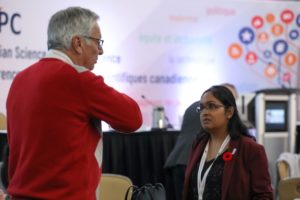
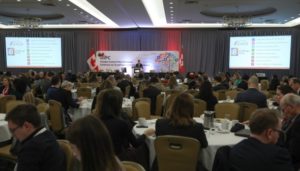

Day 2 – November 8th 2018
Takeaways and recommendations:
Skills and competencies where science and policy meet – MITACS science policy fellows
Speakers: Alejandro Adem, Chief Executive Officer and Scientific Director, Mitacs Inc.; Gail Bowkett, Director, Innovation Policy, Mitacs Inc.; David Castle, Vice-President Research, Professor in the University of Victoria’s School of Public Administration; Scott Findlay, Director of Graduate Studies at the Institute of Environment, University of Ottawa; Katie Gibbs, Co-founder and Executive Director, Evidence for Democracy
Embedded academics learn how evidence can inform policy
If Ottawa and the provinces want to ensure their decisions are informed by the best evidence, they need researchers who understand how government and policymaking work.
“As a researcher I want to know what’s going on in government and I think government wants to know how research informs what they’re doing,” Mitacs CEO and Scientific Director Dr. Alejandro Adem told CSPC delegates.
That was the impetus behind Mitacs’ decision to launch the Canadian Science Policy Fellowships. Modelled on a longstanding program managed by the American Association for the Advancement of Science (AAAS) in the U.S., the two-year-old Canadian pilot program has so far embedded 51 academic researchers and scientists in government, several of whom have since joined the government as public servants.
“These are scientists and researchers who are moving into government for first time. They are working on the policy side and learning how to apply their research background and networks and skills in government policy,” said Gail Bowkett, Mitacs’ Director of Innovation Policy.
The program aims to build science policy capacity within government, and within the broader academic community. Delivered in partnership with the University of Ottawa’s Institute for Science, Society and Policy (ISSP), the one-year fellowships help post-doctoral fellows and academic researchers understand the type of evidence government needs, and how science can best meet those needs. It equips fellows with the skills and competencies required to understand policy and science, communicate scientific knowledge, and advise policy makers.
Mitacs fellows are embedded in various federal departments and agencies, and with the British Columbia government. More provinces are expected to join.
“Oftentimes our thinking, particularly in Canada about science policy, is that it is a federal matter. But there are sub-national dimensions to science policy that we also need to think about because provinces have jurisdiction over a number of things that require evidentiary inputs that they won’t necessarily get directly, or in a relevant or timely way from the federal system,” said Dr. David Castle, Vice-President Research at the University of Victoria.
Addressing skill gaps in science policy
Delegates heard how both researchers and policymakers would benefit from new skills and competencies that would improve government’s ability to incorporate science into its decision making.
Bowkett highlighted a cluster of skills and practices, identified by the European Commission’s Joint Research Centre, to address the gap between the supply of, and demand for, policy-relevant research, and to maximize the value and impact of research in policy:
- Understanding policy & science
- Interpersonal skills
- Synthesizing research
- Managing expert communities
- Communicating scientific knowledge
- Advising policymakers
- Engaging with citizens and stakeholders
- Monitoring & evaluation
“What I like about this framework is that it focuses on a collective skillset, so any one of these clusters applies both to the policymaker side of the equation as well as the scientist/researcher side of equation,” said Bowkett.
Scott Findlay suggested other competencies that need to be developed:
- Distinguishing normative and factual elements and claims,
- The ability to appropriately assess the strength of scientific evidence or lack of, and
- How to request and communicate proper and appropriate evidence summary.
While competencies are important, Findlay stressed that attitudes are an even bigger issue when it comes to linking science and policy. For example, the University of Ottawa professor said “scientific hubris” leads researchers to believe they can advise on research areas where they have little or no expertise.
“The second set of beliefs that I think are problematic has to do with this notion that science is value-free. I would argue that embedded actually in the scientific method there are value issues.” Finlay explained, for example, that not all decisions are made beyond a reasonable doubt and that having a lower standard “in no shape or way, delegitimizes the decision that is being rendered”.
A third problematic belief, said Finlay, is the populist view of science. “It’s this notion that if it’s not important to the public, then it’s not important”. But he said if government is serious about its responsibility to educate and inform the public, “You can’t use the importance of science in the public space as the sole metric for judging whether science, investment in science or taking stock of sciences is an appropriate way to proceed.”
Another issue for Katie Gibbs, Executive Director of Evidence for Democracy, is equipping academic researchers with the skills they need to engage more with policy. She said the biggest mystery for a lot of scientists is how government and the policy process work, including which level of government they should approach, whether they should engage with bureaucrats or politicians first, or even who to talk to within the public service.
Gibbs added that it’s important for academic scientists to also recognize the role social sciences such as public policy, political science and communications play in decision-making.
“There are so many worlds within social sciences that are relevant to scientists who are starting to do policy,” said Gibbs. “Try to seek out those collaborations within these other fields. It’s quite likely there are other people working on the issue you’re interested in.”
How institutions can do better
In a word, “training”, said Gibbs. Science policy fellowships and events like the CSPC or work being done by Evidence for Democracy are steps in the right direction, but their impact will continue to be limited unless there is an effort to incorporate policy skills training into the scientific curriculum at both the undergraduate and graduate levels.
For that to happen, offer incentives to professors to provide this new training component and incentives to students and academics to participate.
Findlay suggested embedding policy training directly in the scientific process, including a recognition that even science is limited. “We have a fairly good idea in training of scientists what science can do and to what it can speak, but we have less clear idea about what it can’t do, its limitations, and what it ought not be trying to speak.”
Scientists also need to disseminate their research in ways that policymakers can access, such as through open access journals. Better yet, write concise evidence summaries that are understandable, digestible and usable to policymakers.
“On the other side of the equation,” added Bowkett, “policymakers need to have a better understanding of what the evidence means and where the evidence comes from and what the scientific process is and the rigour through which that evidence has come through the scientific process.”
However, for that to happen, Findlay said policymakers – or the “evidence consumers” – need training in how to clearly communicate the type of evidence they need.
“We need to set up a system whereby the people who are requesting the scientific evidence do so in a manner that the producers of the scientific evidence have a clear idea of what is required to make the evidence they provide useful to the decision makers,” said Findlay.
At the same time, Bowkett said researchers must recognize that science is just one piece of the puzzle when it comes to policymaking. “Policymaking is messy. There are all kinds of subjective elements to it. There are all kinds of judgement involved. For the scientists, that can be a bit of a head scratcher because you’re standing behind your science, saying, ‘The answer’s right here. Why aren’t you doing what the evidence says?’”
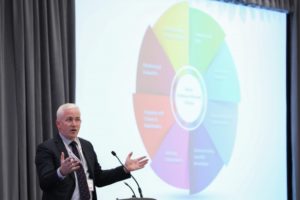
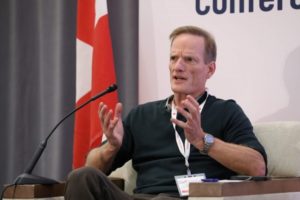
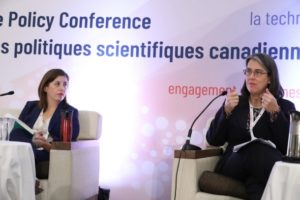
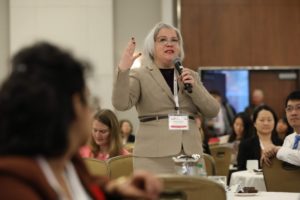

Day 2 – November 8th 2018
Takeaways and recommendations:
A Conversation with Dr. Mona Nemer, Canada’s Chief Science Advisor
One year into her inaugural three-year term, Dr. Mona Nemer remains fiercely committed to her new role of providing science advice to the federal government and championing the power of science to enhance Canadian society and the economy.
Nemer made her second CSPC appearance in as many years as Canada’s Chief Science Advisor (CSA). Her diverse mandate began with “a year of learning” as she crisscrossed the country and traveled internationally to meet with stakeholders, engage with government and speak with the public and the media.
“I did not know what I was getting myself into but I can also tell you that I don’t regret a single moment. It’s been a fantastic year,” she told a packed audience during a luncheon presentation and Q&A with CSPC CEO Mehrdad Hariri. “(The science and technology community) helped us collectively as a community to get our message across to decision makers and to start a constructive dialogue with our colleagues on the policy side.”
Nemer provided several snapshots of her first year, all of which will be covered in greater detail in her first annual report.
“(My) mandate asked me to provide advice and we have provided science advice… One is drafting a model scientific integrity policy which we did with the science union (Professional Institute of the Public Service of Canada) and the Treasury Board of Canada,” Nemer explained. “We now have a code of conduct not only for scientists but also for employers that defines how science ought to be conducted in the absence of any undue influence and also the responsibilities of the scientists themselves and their freedom to communicate about their research with their community and with the public in general.”
The CSA was also asked by Dominic LeBlanc, Minister of Fisheries and Oceans, to lead an expert panel on aquaculture and report on the “appropriate use and consideration of scientific evidence in protecting the marine environment in decision-making.”
Nemer has launched a longer-term initiative to encourage the federal government’s departments and agencies to appoint departmental science advisors to assist them in pulling together science advice from diverse fields on an as-needed basis. The appointments are now being made and will result in a departmental science advisory network that augments existing science advisory expertise.
“I found the UK model interesting … having a network that works with government science advisors which provides technical expertise and a broader network,” said Nemer. “With support from the Minister of Science I have recommended that we deploy such a network and we have several departments who have already hired or are in the process of hiring.”
Nemer explained that short-term advice also falls within the CSA mandate, such as providing input on the implementation of science and research initiatives funded in the 2018 federal budget. The budget plan announced $6.4 billion in new funding for scientific research, technology and business innovation assistance, setting off a flurry of activity to determine how the money would be spent within the government’s guidelines. Nemer noted that the Budget “generated a lot of work after that” but that she was honoured to be part of a team developing recommendations for implementation.
Beyond her duties of providing advice, Nemer has also spent considerable time helping to raise the public profile of science and research, both as an exciting career opportunity and as a tool to further social and economic objectives.
“I was pleased to participate in many events like Let’s Talk Science and [others that enhance] science understanding,” she said. One very successful event was the launch of Science meets Parliament, a partnership with CSPC that brings scientists to Parliament Hill to meet with MPs and Senators. “I would like to encourage everyone to maintain an active dialogue with all our elected officials and decision makers.”
Less visible but no less critical is the CSA’s work within the federal research ecosystem to encourage greater collaboration and multidisciplinary activity. Nemer participated on the new Canada Research Coordinating Committee to establish a coordinated approach to research funding and activities related to the new $275-million Tri-Council Research Fund.
“It is a great priority for our government to see that science and research is conducted in a multidisciplinary manner and that we are actually removing the silos and carrying out research and science as needed in the 21st century,” said Nemer. “(This) requires team approaches, multidisciplinarity and reaching across borders, be it physical country borders and our own institutions.”
